Abstract
A Pd-catalyzed, meta-selective C−H arylation of nosyl-protected phenethylamines, and benzylamines is disclosed using a combination of norbornene and pyridine-based ligands. Subjecting 2-aryl anilines to this protocol lead to meta-C–H arylation at the remote aryl ring. A diverse range of aryl iodides are tolerated in this reaction, along with select heteroaryl iodides. Select aryl bromides bearing ortho-coordinating groups can also be utilized as effective coupling partners in this reaction. The use of pyridine ligands has allowed the palladium loading to be reduced to 2.5 mol%. Furthermore, a catalytic amount of 2-norbornene (20 mol%) to mediate this meta-C–H activation process is demonstrated for the first time. Utilization of a common protecting group as the directing group for meta-C–H activation of amines is an important feature of this reaction in terms of practical applications.
TOC image
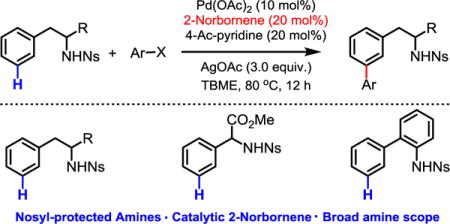
1. Introduction
Amino functional groups play important roles in modulating biological systems and cure disease.1 It is therefore of great synthetic value to develop more efficient and versatile methods to rapidly functionalize amine substrates. Palladium catalyzed C–H functionalization is particularly suited to meet this need as the amine, or protected version thereof, can coordinate with a palladium catalyst and direct the functionalization of a designated C–H bond that is within an appropriate distance. Indeed, free amino groups,2 as well as a variety of modified directing groups,3 have been used to direct transition metal catalysts to ortho-C–H bonds which are proximal to the amino group.4 However, methods which functionalize the distal C–H bonds of these substrates are still somewhat rare. In 2014, our group reported the use of a U-shaped template attached to benzyl amine derived substrates to direct palladium catalyzed meta-C–H olefination and acetoxylation.5b The use of U-shaped templates, originally disclosed by our group in 2012, has led to an array of palladium catalyzed meta-C–H functionalizations.5 In general, this approach requires the design of a suitable template for a particular class of substrates. More recently, inspired by the Catellani reaction,6 an alternative meta-C–H functionalization strategy has been established by relaying the palladium6 from a site of ortho-cyclometalation to the adjacent meta-position.7 This strategy holds significant promise for the development of highly versatile meta-C–H functionalization as it is theoretically compatible with any directing group which can promote ortho-cyclometalation.8 Thus far, two reports have surfaced which concern the use of amine directing groups for meta-C–H arylation using norbornene as a transient mediator.7b,d The Dong group disclosed the use of N, N-dimethylamino directing groups for meta-arylation of benzylamines, though the scope was relatively limited.7b More recently, Zhao and coworkers demonstrated that the bisdentate oxalyl amides derived from phenethylamines are particularly effective substrates for this transformation.7d Considering the broad utility of the nosyl protecting group since its disclosure by Fukuyama in 1995,9 and our long standing interest in developing amino group directed ortho-C–H activation,3 we sought to utilize nosyl protected amines as simple mono-dentate directing groups for norbornene mediated, palladium catalyzed meta-C–H functionalizations of both benzylamines and phenylethylamines. Herein, we report our findings on the use of nosyl protected phenethylamines, benzylamines and 2-arylanilines as substrates in palladium catalyzed meta-C–H arylation using norbornene as a transient mediator. Identification of suitable pyridine type ligands is crucial for this reaction to proceed. In the case of nosyl protected phenethylamines, we were able to demonstrate that norbornene can be used in a catalytic amount for the first time in this meta-C–H functionalization reaction.
2. Results and Discussion
Having previously established several sulfonamide-directed C–H functionalization reactions,3d-m our initial investigations into amine directed meta-C–H arylation began with triflyl-protected substrate 1 and methyl 2-iodobenzoate 2a. Under our previously established conditions for meta-C–H arylation7a using pyridine-based ligand L1, the meta-diarylated product 3aa was obtained in 28% yield as determined by 1H NMR, with less than 5% yield of meta-monoarylated product. Subsequently, we investigated several commonly used N-protecting groups for this meta-arylation to evaluate their effect on the reactivity (table 1). The data from this table indicates that moderately good yields can be obtained under our previously established reaction conditions by fine tuning of the electronics of the sulfonamide. Gratifyingly, the optimal yield was obtained when using nosyl (Ns) as both a directing and protecting group. Not surprisingly, N-Ac, N-TFA, N-Boc, and N-Cbz gave no desired product as we have previously shown that the N-H acidity of sulfonamide directing groups is critical in enabling them to serve as efficient directing groups.3d-m
Table 1.
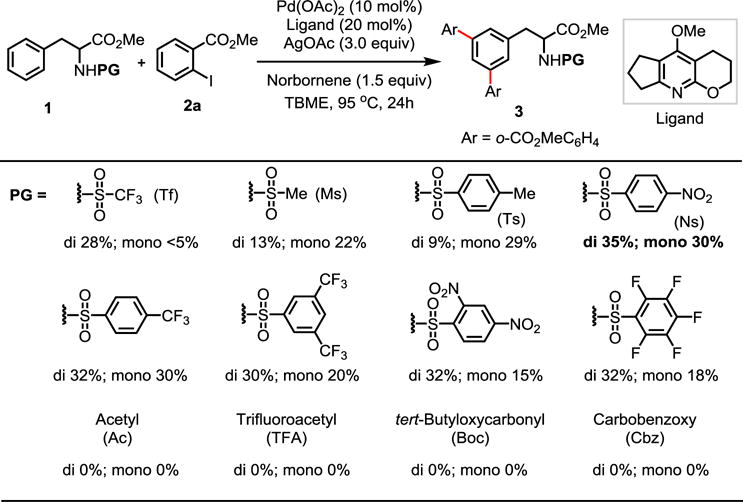
|
Reaction conditions: phenethylamine 1 (0.1 mmol), methyl 2-iodobenzoate 2a (3.0 equiv), Pd(OAc)2 (10 mol%), ligand (20 mol%), 2-norbornene (1.5 equiv), AgOAc (3.0 equiv), TBME (1.0 mL), 95 °C, air, 24 h.
Yields of products 3 were determined by 1H NMR using dibromomethane as an internal standard.
With preliminary conditions for the meta-arylation reaction in hand, we proceeded to systematically re-examine the pyridine ligands in an effort to improve the efficiency of this reaction (Table 2). Prompted by the recent success of L1 and L2 to enable meta-C–H functionalization of phenylacetic amides using a norbornene relay approach, we began our investigations with L1 and L2.7a,c Both ligands only promoted the reaction to a moderate extent, even after substantial optimization. Further evaluation of di-substituted N-heterocycles L3 (2,6-lutidine) and L4 (2,6-dimethoxypyridine) revealed that these 2,6-disubstituted pyridines do not effectively promote this reaction. Subsequently, we found that 2-alkoxy pyridines (L5 and L6) also were not efficient for this reaction. A further evaluation of pyridines with 2-substitution lead to the realization that pyridines bearing electron-withdrawing substituents at this position (L7–L10) are completely inactive. In contrast, 2-alkylpyridine (L11–13) ligands were found to be highly effective in promoting this transformation, affording excellent yields of the desired products (>92%). While the impact of the electron-withdrawing and donating substituents at the 2-positions are different, a variety of 3- and 4-substituted pyridine ligands (L14–L23) provided excellent yields (≥95%), with the exception of the highly electron deficient L18 and 4-(dimethylamino)pyridine L19. Among the evaluated ligands, 4-acetylpyridine (L23) gave the best result by enabling the desired product to be formed in 99% yield as determined by 1H NMR using dibromomethane as an internal standard. Surprisingly, we found that simple pyridine (L24) and pyrazine (L25) are also suitable ligands for this reaction allowing formation of the di-arylated products in high yields. A key control experiment showed that pyridine-type ligands are crucial for the formation of meta-arylated product, as no reaction occurred in the absence of ligand.
Table 2.
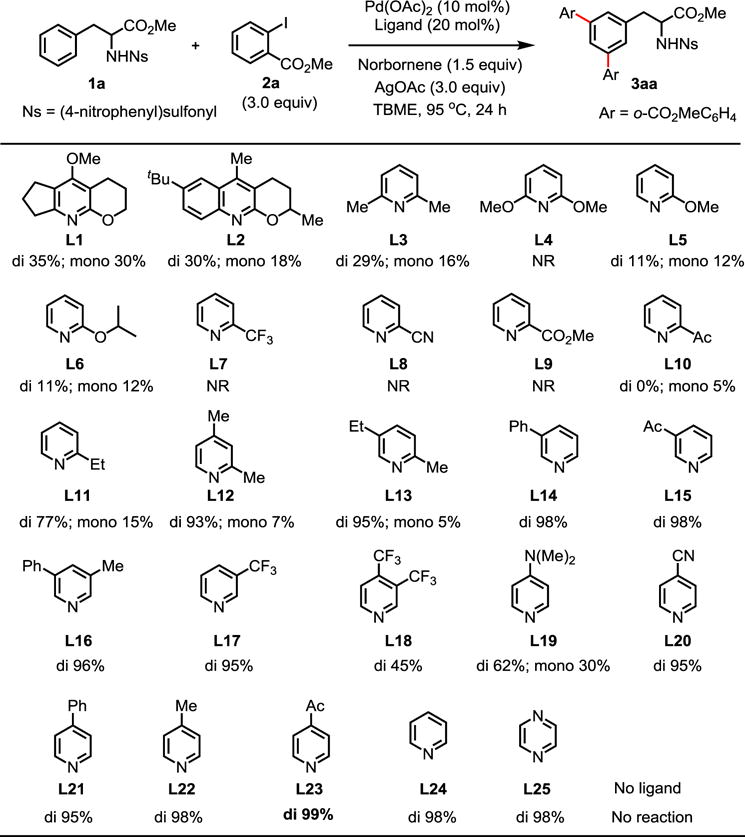
|
Reaction conditions: substrate 1a (0.1 mmol), methyl 2-iodobenzoate 2a (3.0 equiv), Pd(OAc)2 (10 mol%), ligand (20 mol%), 2-norbornene (1.5 equiv), AgOAc (3.0 equiv), TBME (1.0 mL), 95 °C, air, 24 h.
Yield of product 3aa was determined by 1H NMR using dibromomethane as an internal standard.
Considering that our previous arylation reactions require a high loading of catalyst (10 mol%) and 2-norbornene (NBE, 1.5 equiv),7a we attempted to reduce the equivalents of these catalysts. The use of 5 mol% of Pd(OAc)2 provided a mixture of di- and mono-arylated products in 85%, and 15% yield, respectively. The catalyst loading could be further reduced to 2.5 mol%, leading to arylated products in 90% yield (di/mono = 1.2/1). We were pleased to find that the loading of NBE could be reduced to 20 mol% without changing the reactivity and selectivity. Even using 10 mol% NBE could provide the desired product in high yield (93%) with moderate mono/di selectivity (di/mono = 2.9/1). Furthermore, decreasing the reaction temperature to 80 °C did not result in a reduction of efficiency for the reaction, allowing clean formation of the diarylated product 3aa in nearly quantitative yield (see SI).
Using 10 mol% palladium and 20 mol% NBE, we began to explore the meta-arylation reaction of various substrates derived from phenethylamines (1a-1t) using methyl 2-iodobenzoate 2a as the coupling partner (Table 3). Both electron-donating and -withdrawing ortho-substituents (such as methoxy, methyl, bromo, fluoro, chloro, and trifluoromethyl) on the aryl ring are well-tolerated in this transformation, affording good to excellent yields of the products (3ba-3ha). Excitingly, the arylation of the ortho-bromide substituted 1d under the standard conditions gives desired product 3da in 85% yield, leaving the C-Br bond intact. A range of electron-donating and –withdrawing meta-substituted substrates could also be converted to the meta-arylated products (3ia-3ma) in good yields (82–92%). The arylation of para-substituted substrates 1n and 1o gives the monoarylation products 3na and 3oa in moderate yields as the major products, with less than 10% diarylation products. However, the less sterically hindered para-fluoro substituted substrate 1p is transformed to the diarylation product 3pa in excellent yield (90%). This meta-arylation method is also compatible with phenylalaninol derived substrates 1q and 1r with formation of the desired products 3qa in 55% yield (mono/di = 2/1) and 3ra (di) in 76% yield. It is important to note that the unprotected alcohol in 1q was well tolerated to provide product 3qa. This is likely due to a chelate effect whereby bisdentate coordination of the nosyl amine and the free alcohol to Pd(II) prevents oxidation of the alcohol by Pd(II). Meta-arylation of amphetamine derived substrates 1s and 1t also proceeds in smoothly to give the desired products (3sa and 3ta). Attesting to the mildness of this reaction, no racemization was observed in this meta-arylation reaction when L-phenylalanine derived 1a (>99% ee) was used as the substrate under the standard reaction conditions (see SI for HPLC data).
Table 3.
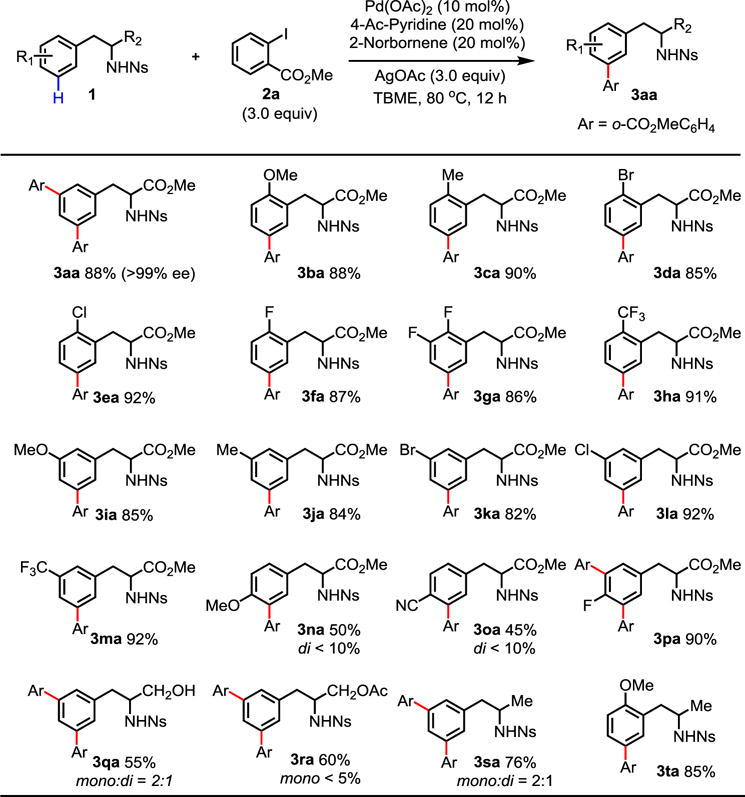
|
Reaction conditions: substrate 1 (0.1 mmol), methyl 2-iodobenzoate 2a (3.0 equiv), Pd(OAc)2 (10 mol%), 4-acetylpyridine (20 mol%), AgOAc (3.0 equiv), 2-norbornene (20 mol%), TBME (1.0 mL), 80 °C, 12 h.
Isolated yield.
To further explore the synthetic utility of this protocol, we proceeded to examine the scope of aryl halides to obtain structurally versatile meta-arylated phenethylamines (Table 4). Aryl halides with an ortho-coordinating, electron-withdrawing group serve as the most efficient coupling partners affording the desired products (3ja-je) in good to excellent yields. Importantly, aryl bromides containing ortho electron-withdrawing groups are also suitable for this reaction as exemplified by the efficient preparation of 3ja and 3je. This constitutes the first demonstration of using aryl bromides as coupling partners when using this meta-arylation strategy. Notably, the arylation reaction is compatible with 1-chloro-2-iodobenzene, despite affording a lower yield (3jf, 40%). Electron-donating and –withdrawing meta- and para-substituted aryl iodides are also tolerated in this transformation, affording the desired products (3jg-3jr) in moderate yields when using 1.5 equivalents of NBE. In cases where the aryl iodide is less reactive, the benzocyclobutene side product is also formed. Given the importance of heterocyclic compounds in the pharmaceutical industry, we examined a variety of heterocyclic iodides to prepare compounds which may be of interest in drug discovery. The results showed that meta-arylated product 3js could be obtained in 53% yield when tosyl-protected indolyl iodide was coupled with substrate 1j. Furthermore, aryl iodides containing dioxane moieties provided the desired product 3jt in 50% yield. Finally, 4-pyridyl iodides with halogens at the 2-position are also compatible with the protocol leading to 3ju and 3jv in moderate yields.
Table 4.
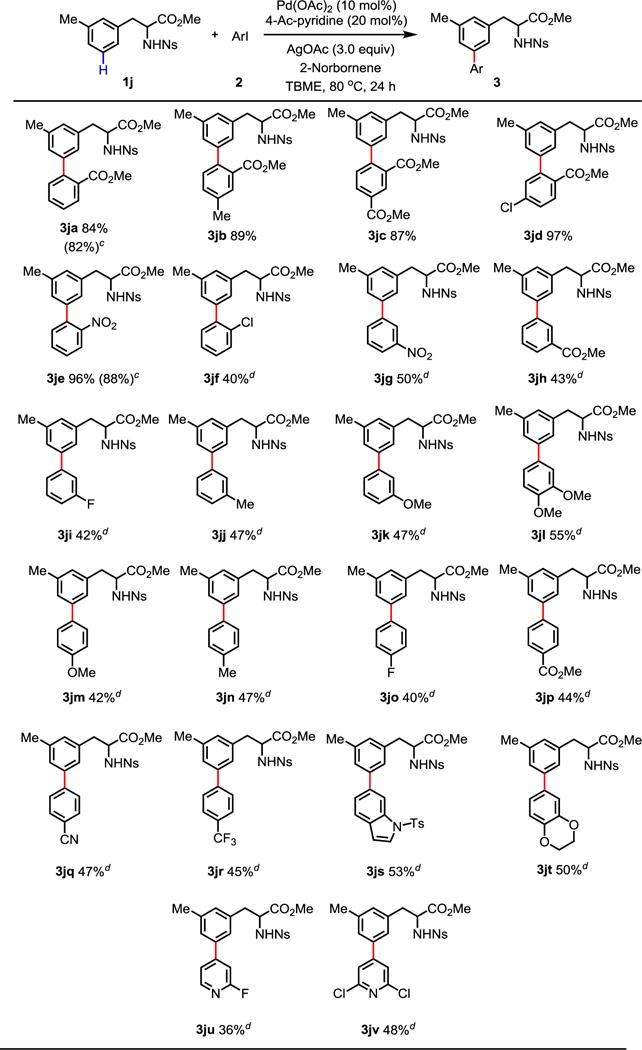
|
Reaction conditions: 1j (0.1 mmol), aryl halides 2 (3.0 equiv), Pd(OAc)2 (10 mol%), 4-acetylpyridine (20 mol%), 2-norbornene (20 mol%), AgOAc (3.0 equiv), TBME (1.0 mL), 80 °C, 24 h.
Isolated yield.
Isolated yields in parentheses when aryl bromide was used instead of aryl iodide.
3.0 equiv of 2-norbornene was used.
Interested in exploring the generality of NHNs directed meta-C–H arylation using norbornene as a transient mediator, we investigated the feasibility of using 2-aryl anilines as substrates (Table 5). Unlike our prior work on aniline substrates which functionalizes the meta-position of the aniline ring,7e,f NHNs directed palladation is expected to occur on the adjacent ring to form a 6-membered palladacycle which would be intercepted by norbornene to provide meta-arylation of the adjacent ring. Gratifyingly, Ns-protected 2-phenyl aniline 4a was smoothly converted to the diarylated product 5a in 60% yield with a trace amount of monoarylated product and trace benzocyclobutene byproduct when employing 1.5 equivalents of norbornene. Meta-arylation of substituted 2-aryl anilines 4b and 4c gave the corresponding products 5b and 5c in 60% and 80% yields, respectively. We were pleased to find that aryl iodides containing both electron-withdrawing and –donating substituents on the meta- and para- positions are tolerated, affording meta-arylated products 5e-5g in moderate yields. Tosyl-protected indolyl iodide is also an effective electrophile, providing the desired product 5h in 53% yield.
Table 5.
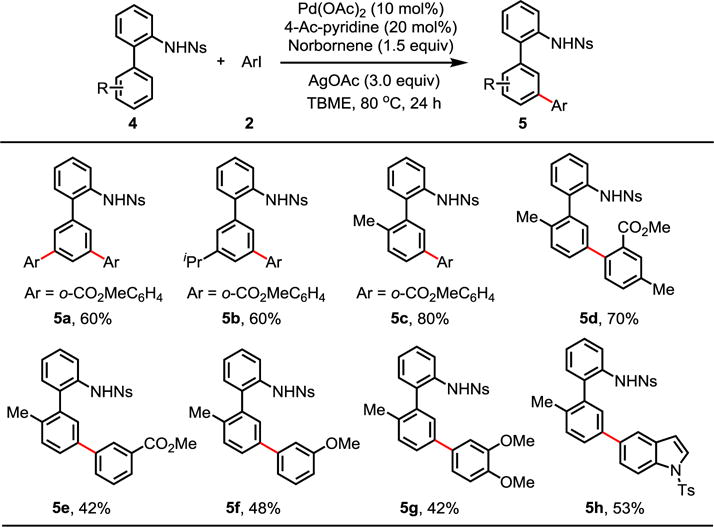
|
Rection conditions: 4 (0.1 mmol), aryl iodides 2 (3.0 equiv), Pd(OAc)2 (10 mol%), 4-acetylpyridine (20 mol%), 2-norbornene (1.5 equiv), AgOAc (3.0 equiv), TBME (1.0 mL), 80 °C, 24 h.
Isolated yield.
We recently described the site-selective functionalizations of inert C(sp3)-H bonds of N-terminal amino acids in di-, tri-, and tetra-peptides, providing a broad range of corresponding peptides with modified phenylalanine residues.10 This prompted us to explore the utility of nosyl-protected β-aryldipeptides under our standard conditions for NHNs directed meta-C–H arylation (Table 6). Dipeptides 6a and 6b derived from L-valine and L-alanine were smoothly arylated to give the mono- and diarylation products 7a and 7b in 80% and 67% combined yields, respectively. Meta-arylation of dipeptide 6c also underwent effective coupling using aryl iodides containing electron-withdrawing groups as coupling partners to provide the desired products 7c and 7d in good yields.
Table 6.
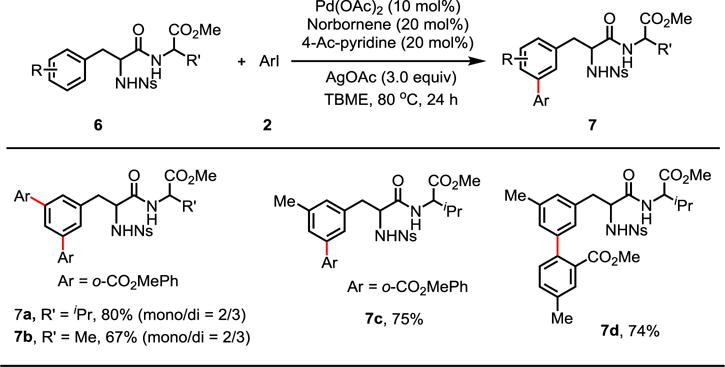
|
Reaction conditions: 6 (0.1 mmol), aryl iodides 2 (3.0 equiv), Pd(OAc)2 (10 mol%), 4-acetylpyridine (20 mol%), 2-norbornene (20 mol%), AgOAc (3.0 equiv), TBME (1.0 mL), 80 °C, 24 h.
Isolated yield.
Considering the biological importance of meta-arylated benzylamines,1 we also attempted the meta-arylation reaction using methyl phenylglycine derivative 8 as a model substrate (Scheme 2). Initially, arylation with methyl-2-iodobenzoate 2a using 20 mol% 4-acetylpyridine afforded the desired product in low yield (45%). Given the wide range of pyridine ligands that can promote this reaction, we re-evaluated a variety of the best ligands and found that simple pyridine functions as a more efficient ligand when utilizing this substrate, affording the desired products in 70% yield (9amono/9adi=1/1). Various aryl iodides containing an ortho electron-withdrawing group worked well in the reaction when using this substrate.
Scheme 2.
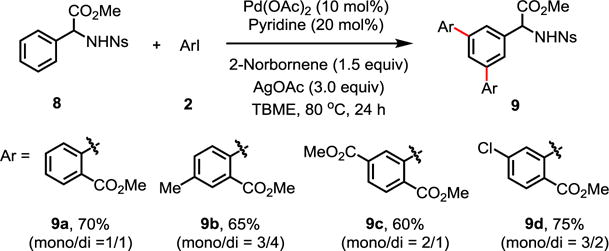
Meta-Arylationof Benzylamine derived Sulfonamide 8 with Aryl Iodides 2
To investigate the feasibility of using this reaction on a preparative scale, we carried out a gram scale meta-C(sp2)–H arylation reaction with substrate 1a and methyl-2-iodobenzoate 2a (Scheme 3). The desired product 3aa could be isolated in 85% yield when the reaction was run on a 3.0 mmol scale. The protecting group (Ns) could also be readily removed by treatment with 4-methoxybenzenethiol and K2CO3 in MeCN/DMSO at room temperature to yield the free amine in excellent yield (Scheme 4).9
Scheme 3.

Gram-Scale Synthesis
Scheme 4.

Deprotection
To showcase the synthetic utility of this reaction, a copper-catalyzed intramolecular amination/oxidation sequence of 3da has been developed in the presence of CsOAc to give 2,5-disubstituted indole derivative 1 (Scheme 5).11
Scheme 5.

Application
Based on previous reports,6,7 a plausible mechanism for this meta-C(sp2)–H arylation using NBE as a transient mediator is presented in Figure 1. Firstly, palladium(II)-mediated ortho-C(sp2)–H activation of substrate 1 could result in an organopalladium(II) complex I which can subsequently react with NBE to generate intermediate II. Secondly, meta-C–H activation of intermediate II would lead to 5-membered palladacyclic intermediate III which can undergo oxidative addition with the aryl halide to form organopalladium(IV) complex IV. This palladium(IV) species IV can then undergo a new C-C bond forming reductive elimination, which is followed by subsequent β-carbon elimination of NBE to afford the meta-arylation product and regenerate the palladium(II) catalyst. Importantly, though intermediates III and IV can undergo reductive elimination to yield the cyclobutane adduct as the major side-product, 2-norbornene can effectively be used as a catalyst in this reaction.
Figure 1.
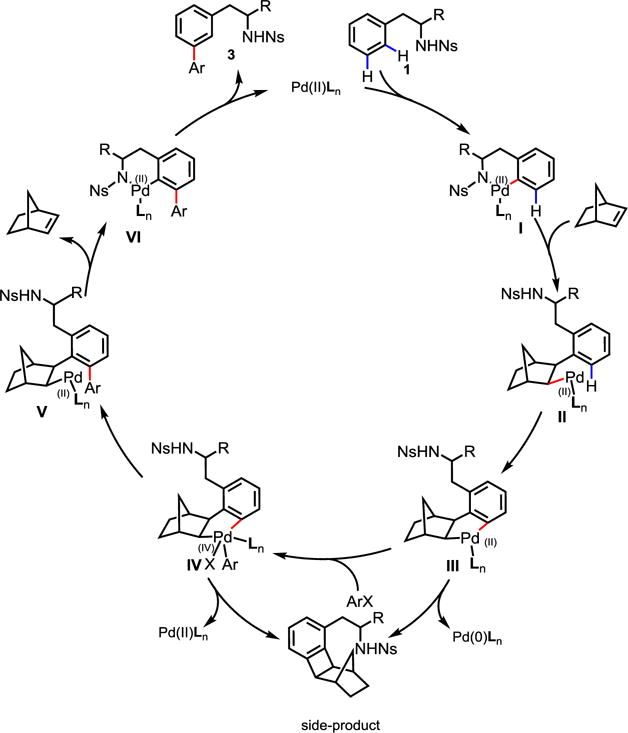
Plausible mechanism of directed meta-C-H Arylation. Ln = 4-acetylpyridine (L23).
3. Conclusion
In summary, we have developed a Pd(II)-catalyzed meta-C(sp2)–H arylation of nosyl protected aryl ethylamines, 2-aryl anilines, and phenylglycine using norbornene as a transient mediator in combination with pyridine ligands. The use of a catalytic amount of norbornene for this meta-C–H functionalization strategy is demonstrated for the first time. The new method is compatible with various aryl iodides containing both electron-donating and electron-withdrawing substituents at the ortho, meta, and para position, as well as select aryl bromides. In addition, select heteroaryl iodides are tolerated in this transformation. This study suggests that ligand development and reaction tuning is the key to extending this approach to a wide range of substrate classes which use native functionality or common protecting groups as directing groups.
4. Experimental Section
4.1 General Procedure for meta-C(sp2)–H Arylation of Nosyl Protected Phenethylamines
Substrate 1 (0.10 mmol), Pd(OAc)2 (0.01 mmol, 2.2 mg), and AgOAc (0.30 mmol, 50.0 mg) were weighed in air and placed in a sealed tube (10 mL) with a magnetic stir bar. To the reaction mixture, 4-acetylpyridine (0.02 mmol, 2.2 μL), norbornene (0.02 mmol, 1.9 mg), aryl halide 2 (0.3 mmol), and TBME (1.0 mL) were added. The reaction mixture was heated to 80 °C for 12 to 24 hours under vigorous stirring. Upon completion, the reaction mixture was cooled to room temperature, diluted with ethyl acetate, and filtered through a pad of celite. The filtrate was concentrated in vacuo, and the resulting residue purified by preparative TLC using an eluent of hexanes/ethyl acetate(2/1 to 4/1) to give the desired products 3.
4.2 General Procedure for meta-C(sp2)–H Arylation of Nosyl Protected 2-Aryl Anilines
The starting material 4 (0.10 mmol), Pd(OAc)2 (0.01 mmol, 2.2 mg), and AgOAc (0.30 mmol, 50.0 mg) were weighed in air and placed in a sealed tube (10 mL) with a magnetic stir bar. To the reaction mixture, 4-acetylpyridine (0.02 mmol, 2.2 μL), norbornene (0.15 mmol, 14.0 mg), aryl iodide 2 (0.3 mmol), and TBME (1.0 mL) were added. The reaction mixture was heated to 80 °C for 24 hours under vigorous stirring. Upon completion, the reaction mixture was cooled to room temperature, diluted with ethyl acetate, and filtered through a pad of celite. The filtrate was concentrated in vacuo, and the resulting residue purified by preparative TLC using an eluent of hexanes/ethyl acetate (2/1 to 4/1) to give the desired products 5.
4.3 General Procedure for meta-C(sp2)–H Arylation of Nosyl Protected β-Aryl Dipeptides 6
The starting material 6 (0.10 mmol), Pd(OAc)2 (0.01 mmol, 2.2 mg), and AgOAc (0.30 mmol, 50.0 mg) were weighed in air and placed in a sealed tube (10 mL) with a magnetic stir bar. To the reaction mixture, 4-acetylpyridine (0.02 mmol, 2.2 μL), norbornene (0.02 mmol, 1.9 mg), aryl iodide 2 (0.3 mmol), and TBME (1.0 mL) were added. The reaction mixture was heated to 80 °C for 24 hours under vigorous stirring. Upon completion, the reaction mixture was cooled to room temperature, diluted with ethyl acetate, and filtered through a pad of celite. The filtrate was concentrated in vacuo, and the resulting residue purified by preparative TLC using an eluent of hexanes/ethyl acetate (2/1 to 4/1) to give the desired products 7.
4.4 General Procedure for meta-C(sp2)–H Arylation of Nosyl Protected Methyl Phenylglycine 8
Phenylglycine 8 (0.10 mmol), Pd(OAc)2 (0.01 mmol, 2.2 mg), and AgOAc (0.30 mmol, 50.0 mg) were weighed in air and placed in a sealed tube (10 mL) with a magnetic stir bar. To the reaction mixture, pyridine (0.02 mmol, 1.6 μL), norbornene (0.15 mmol, 14.0 mg), aryl iodide 2 (0.3 mmol), and TBME (1.0 mL) were added. The reaction mixture was heated to 80 °C for 24 hours under vigorous stirring. Upon completion, the reaction mixture was cooled to room temperature, diluted with ethyl acetate, and filtered through a pad of celite. The filtrate was concentrated in vacuo, and the resulting residue purified by preparative TLC using an eluent of hexanes/ethyl acetate (2/1 to 4/1) to give the desired products 9.
Supplementary Material
Scheme 1.
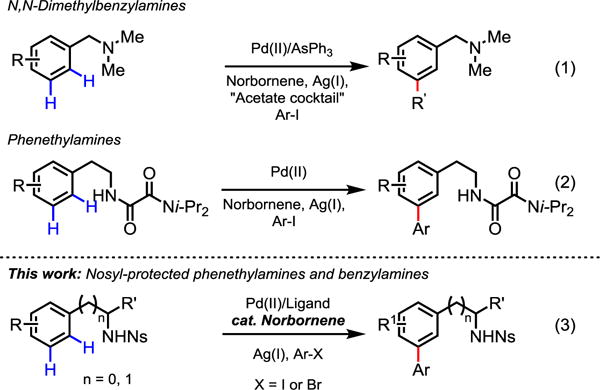
Palladium-Catalyzed Meta-C–H Arylation of Amines
Acknowledgments
We gratefully acknowledge The Scripps Research Institute and the NIH (NIGMS, 2R01 GM102265) for financial support. We thank the scholarship from “Jiangxi Normal University” and “Jiangxi Provincial Association of Science and Technology” for funding a visiting student (Ding, Q.).
Footnotes
Supporting Information Available. Detailed experimental procedures, characterization of new compounds. This material is available free of charge via the Internet at http://pubs.acs.org.
References
- 1.(a) Vitaku E, Smith DT, Njardarson JT. J Med Chem. 2014;57:10257. doi: 10.1021/jm501100b. [DOI] [PubMed] [Google Scholar]; (b) Hili R, Yudin AK. Nat Chem Biol. 2006;2:284. doi: 10.1038/nchembio0606-284. [DOI] [PubMed] [Google Scholar]; (c) Lawrence SA. Amines: Synthesis Properties and Applications. Cambridge University Press; Cambridge: 2004. pp. 265–305. [Google Scholar]; (d) Ricci A, editor. Amino Group Chemistry, From Synthesis to the Life Sciences. Wiley-VCH; Weinheim, Germany: 2007. [Google Scholar]
- 2.For select examples of primary and secondary amine directed C–H activation, see:; (a) Lazareva A, Daugulis O. Org Lett. 2006;8:5211. doi: 10.1021/ol061919b. [DOI] [PubMed] [Google Scholar]; (b) Liang Z, Feng R, Yin H, Zhang Y. Org Lett. 2013;15:4544. doi: 10.1021/ol402207g. [DOI] [PubMed] [Google Scholar]; (c) Liang Z, Yao J, Wang K, Li H, Zhang Y. Chem Eur J. 2013;19:16825. doi: 10.1002/chem.201301229. [DOI] [PubMed] [Google Scholar]; (d) Miura M, Feng CG, Ma S, Yu JQ. Org Lett. 2013;15:5258. doi: 10.1021/ol402471y. [DOI] [PubMed] [Google Scholar]; (e) McNally A, Haffenmayer B, Collins BSL, Gaunt MJ. Nature. 2014;510:129. doi: 10.1038/nature13389. [DOI] [PubMed] [Google Scholar]; (f) Calleja J, Pla D, Gorman TW, Domingo V, Haffenmayer B, Gaunt MJ. Nature Chem. 2015;7:1009. doi: 10.1038/nchem.2367. [DOI] [PubMed] [Google Scholar]; (g) Hu C, Gaunt MJ. Angew Chem Int Ed. 2015;54:15840. doi: 10.1002/anie.201508912. [DOI] [PubMed] [Google Scholar]; For select examples of tertiary amine directed C–H activation, see:; (h) Cai G, Fu Y, Li Y, Wan X, Shi Z. J Am Chem Soc. 2007;129:7666. doi: 10.1021/ja070588a. [DOI] [PubMed] [Google Scholar]; (i) Gao DW, Shi YC, Gu Q, Zhao ZL, You SL. J Am Chem Soc. 2013;135:86. doi: 10.1021/ja311082u. [DOI] [PubMed] [Google Scholar]; (j) Feng R, Yao J, Liang Z, Liu Z, Zhang Y. J Org Chem. 2013;78:3688. doi: 10.1021/jo400186p. [DOI] [PubMed] [Google Scholar]; (k) Tan PW, Haughey M, Dixon DJ. Chem Commun. 2015;51:4406. doi: 10.1039/c5cc00410a. [DOI] [PubMed] [Google Scholar]
- 3.For seminal reports of directing groups which have found broad utility in amine directed C–H activation, see:; (a) Zaitsev VG, Shabashov D, Daugulis O. J Am Chem Soc. 2005;127:13154. doi: 10.1021/ja054549f. [DOI] [PubMed] [Google Scholar]; (b) Rodriguez N, Romero-Revilla JA, Fernandez-Ibanez MA, Carretero JC. Chem Sci. 2013;4:175. [Google Scholar]; (c) Wang C, Chen C, Zhang J, Han J, Wang Q, Guo K, Liu P, Guan M, Yao Y, Zhao Y. Angew Chem, Int Ed. 2014;53:9884. doi: 10.1002/anie.201404854. [DOI] [PubMed] [Google Scholar]; For examples of Sulfonamide directed C–H activation, see:; (d) Li JJ, Mei TS, Yu JQ. Angew Chem Int Ed. 2008;47:6452. doi: 10.1002/anie.200802187. [DOI] [PubMed] [Google Scholar]; (e) Wang X, Mei TS, Yu JQ. J Am Chem Soc. 2009;131:7520. doi: 10.1021/ja901352k. [DOI] [PubMed] [Google Scholar]; (f) Mei T-S, Wang X, Yu J-Q. J Am Chem Soc. 2009;131:10806. doi: 10.1021/ja904709b. [DOI] [PubMed] [Google Scholar]; (g) Vickers CJ, Mei TS, Yu JQ. Org Lett. 2010;12:2511. doi: 10.1021/ol1007108. [DOI] [PubMed] [Google Scholar]; (h) Chu L, Wang XC, Moore CE, Rheingold AL, Yu JQ. J Am Chem Soc. 2013;135:16344. doi: 10.1021/ja408864c. [DOI] [PubMed] [Google Scholar]; (i) Chu L, Xiao KJ, Yu JQ. Science. 2014;346:451. doi: 10.1126/science.1258538. [DOI] [PMC free article] [PubMed] [Google Scholar]; (j) Chan KSL, Wasa M, Chu L, Laforteza BN, Miura M, Yu J-Q. Nat Chem. 2014;6:146. doi: 10.1038/nchem.1836. [DOI] [PMC free article] [PubMed] [Google Scholar]; (k) Chan KSL, Fu H, Yu J-Q. J Am Chem Soc. 2015;137:2042. doi: 10.1021/ja512529e. [DOI] [PMC free article] [PubMed] [Google Scholar]; (l) Laforteza BN, Chan KSL, Yu J-Q. Angew Chem Int Ed. 2015;54:11143. doi: 10.1002/anie.201505204. [DOI] [PMC free article] [PubMed] [Google Scholar]; (m) Jiang H, He J, Liu T, Yu JQ. J Am Chem Soc. 2016;138:2055. doi: 10.1021/jacs.5b13462. [DOI] [PMC free article] [PubMed] [Google Scholar]
- 4.For a review on meta- and para-C–H activation, see:; Li J, De Sarkar S, Ackermann L. Top Organomet Chem. 2016;55:217. [Google Scholar]
- 5.For select examples of template directed meta-C–H functionalization, see:; (a) Leow D, Li G, Mei TS, Yu JQ. Nature. 2012;486:518. doi: 10.1038/nature11158. [DOI] [PMC free article] [PubMed] [Google Scholar]; (b) Tang R, Li G, Yu JQ. Nature. 2014;507:215. doi: 10.1038/nature12963. [DOI] [PMC free article] [PubMed] [Google Scholar]; (c) Wan L, Dastbaravardeh N, Li G, Yu JQ. J Am Chem Soc. 2013;135:18056. doi: 10.1021/ja410760f. [DOI] [PMC free article] [PubMed] [Google Scholar]; (d) Chu L, Shang M, Tanaka K, Chen Q, Pissarnitski N, Streckfuss E, Yu JQ. ACS Cent Sci. 2015;1:394. doi: 10.1021/acscentsci.5b00312. [DOI] [PMC free article] [PubMed] [Google Scholar]; For examples of meta-C–H borylation using a non-covalent templating approach, see:; (e) Kuninobu Y, Ida H, Nishi M, Kanai M. Nat Chem. 2015;7:712. doi: 10.1038/nchem.2322. [DOI] [PubMed] [Google Scholar]; (f) Davis HJ, Mihai MT, Phipps RJ. J Am Chem Soc. 2016;138:12759. doi: 10.1021/jacs.6b08164. [DOI] [PubMed] [Google Scholar]; For examples of template directed para-C–H functionalization, see:; (g) Bag S, Patra T, Modak A, Deb A, Maity S, Dutta U, Dey A, Kancherla R, Maji A, Hazra A, Bera M, Maiti D. J Am Chem Soc. 2015;137:11888. doi: 10.1021/jacs.5b06793. [DOI] [PubMed] [Google Scholar]; (h) Patra T, Bag S, Kancherla R, Mondal A, Dey A, Pimparkar S, Agasti S, Modak A, Maiti D. Angew Chem Int Ed. 2016;55:7751. doi: 10.1002/anie.201601999. [DOI] [PubMed] [Google Scholar]
- 6.For pioneering work on the Catellani reaction, see:; (a) Catellani M, Frignani F, Rangoni A. Angew Chem Int Ed. 1997;36:119. [Google Scholar]; For reviews on the Catellani reaction, see:; (b) Catellani M. Top Organomet Chem. 2005;14:21. [Google Scholar]; (c) Martins A, Mariampillai B, Lautens M. Top Curr Chem. 2009;292:1. doi: 10.1007/128_2009_13. [DOI] [PubMed] [Google Scholar]; (d) Ye J, Lautens M. Nat Chem. 2015;7:863. doi: 10.1038/nchem.2372. [DOI] [PubMed] [Google Scholar]; (e) Della Ca’ N, Fontana M, Motti E, Catellani M. Acc Chem Res. 2016;49:1389. doi: 10.1021/acs.accounts.6b00165. [DOI] [PubMed] [Google Scholar]
- 7.(a) Wang XC, Gong W, Fang LZ, Zhu RY, Li S, Engle KM, Yu JQ. Nature. 2015;519:334. doi: 10.1038/nature14214. [DOI] [PMC free article] [PubMed] [Google Scholar]; (b) Dong Z, Wang J, Dong G. J Am Chem Soc. 2015;137:5887. doi: 10.1021/jacs.5b02809. [DOI] [PubMed] [Google Scholar]; (c) Shen PX, Wang XC, Wang P, Zhu RY, Yu JQ. J Am Chem Soc. 2015;137:11574. doi: 10.1021/jacs.5b08914. [DOI] [PMC free article] [PubMed] [Google Scholar]; (d) Han J, Zhang L, Zhu Y, Zheng Y, Chen X, Huang ZB, Shi DQ, Zhao Y. Chem Comm. 2016;52:6903. doi: 10.1039/c6cc02384c. [DOI] [PubMed] [Google Scholar]; (e) Wang P, Farmer ME, Huo X, Jain P, Shen PX, Ishoey M, Bradner JE, Wisniewski SR, Eastgate MD, Yu JQ. J Am Chem Soc. 2016;138:9269. doi: 10.1021/jacs.6b04966. [DOI] [PMC free article] [PubMed] [Google Scholar]; (f) Wang P, Li GC, Jain P, Farmer ME, He J, Shen PX, Yu JQ. J Am Chem Soc. 2016;138:14092. doi: 10.1021/jacs.6b08942. [DOI] [PMC free article] [PubMed] [Google Scholar]
- 8.For alternative meta-C–H functionalization strategies proceeding via proposed ortho-cyclometalated intermediates, see the following. For examples Ru(II) catalyzed meta-C–H functionalization using ortho-directing groups, see:; (a) Saidi O, Marafie J, Ledger AEW, Liu PM, Mahon MF, Kociok-Köhn G, Whittlesey MK, Frost CG. J Am Chem Soc. 2011;133:19298. doi: 10.1021/ja208286b. [DOI] [PubMed] [Google Scholar]; (b) Hofmann N, Ackermann L. J Am Chem Soc. 2013;135:5877. doi: 10.1021/ja401466y. [DOI] [PubMed] [Google Scholar]; (c) Li J, Warratz S, Zell D, De Sarkar S, Ishikawa EE, Ackermann L. J Am Chem Soc. 2015;137:13894. doi: 10.1021/jacs.5b08435. [DOI] [PubMed] [Google Scholar]; (d) Teskey CJ, Lui AYW, Greaney MF. Angew Chem, Int Ed. 2015;54:11677. doi: 10.1002/anie.201504390. [DOI] [PMC free article] [PubMed] [Google Scholar]; (e) Paterson AJ, John Campbell S, Mahon MF, Press NJ, Frost CG. Chem Commun. 2015;51:12807. doi: 10.1039/c5cc03951g. [DOI] [PubMed] [Google Scholar]; (f) Fan Z, Ni J, Zhang A. J Am Chem Soc. 2016;138:8470. doi: 10.1021/jacs.6b03402. [DOI] [PubMed] [Google Scholar]; For examples of Cu(II) promoted meta-C–H functionalization using ortho-directing groups, see:; (g) Phipps RJ, Gaunt MJ. Science. 2009;323:1593. doi: 10.1126/science.1169975. [DOI] [PubMed] [Google Scholar]; (h) Duong HA, Gilligan RE, Cooke ML, Phipps RJ, Gaunt MJ. Angew Chem, Int Ed. 2011;50:463. doi: 10.1002/anie.201004704. [DOI] [PubMed] [Google Scholar]; (i) Yang Y, Li R, Zhao Y, Zhao D, Shi Z. J Am Chem Soc. 2016;138:8734. doi: 10.1021/jacs.6b05777. [DOI] [PubMed] [Google Scholar]
- 9.(a) Kan T, Fukuyama T. Chem Comm. 2004:353. doi: 10.1039/b311203a. [DOI] [PubMed] [Google Scholar]; (b) Fukuyama T, Jow CK, Cheung M. Tetrahedron Lett. 1995;36:6373. [Google Scholar]
- 10.Gong W, Zhang G, Liu T, Giri R, Yu JQ. J Am Chem Soc. 2014;136:16940. doi: 10.1021/ja510233h. [DOI] [PMC free article] [PubMed] [Google Scholar]
- 11.Tokyama H, Noji T, Okano K, Fukuyama T, Zhang L. Org Synth. 2011;88:388. [Google Scholar]
Associated Data
This section collects any data citations, data availability statements, or supplementary materials included in this article.


